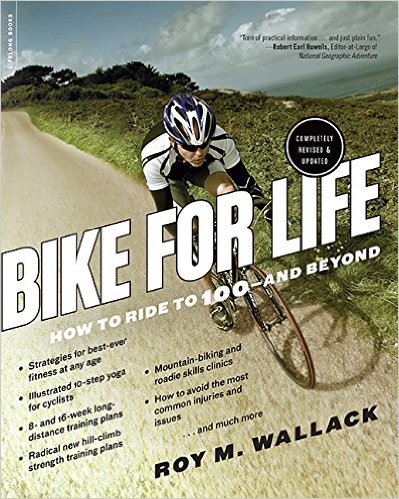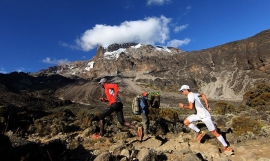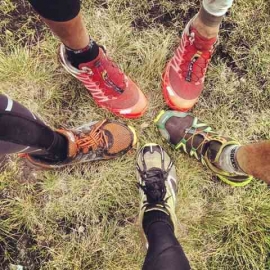Roy M. Wallack 出版书籍合集:
跑步书籍:
Barefoot Running Step by Step_Roy M. Wallack、Barefoot Ken Bob Saxton_2011
自行车书籍:
The Traveling Cyclist_Roy M. Wallack_1991
Bike for Life: How to Ride to 100_Roy M. Wallack_2005
Bike for Life: How to Ride to 100--and Beyond_Roy M. Wallack_2015
其他运动书籍:
Fire Your Gym! Simplified High-Intensity Workouts You Can Do At Home_Roy M. Wallack_2013
Bike for Life: How to Ride to 100--and Beyond
Do You Want to Ride to 100—and Beyond?
BIKE FOR LIFE!
Now with training plans, worldwide adventures, and more than 200 photos
Ride a century when you turn a century: that was the promise Bike for Life offered when it was first published. A decade later, this blueprint for using cycling to achieve exceptional longevity, fitness, and overall well-being has helped tens of thousands of cyclists to ride longer and stronger. Now, nationally-known fitness journalist and lifelong endurance road and mountain biker Roy M. Wallack builds upon his comprehensive Bike for Life plan with even more practical tips and strategies to keep you riding to 100—and beyond.
Fully updated, revised, and illustrated, Bike for Life features:
- Cutting-edge workout strategies for achieving best-ever fitness at any age
- Science-based 8- and 16-week Century training schedules
- A radical new workout method that'll make you fly up the hills
- An anti-aging plan to revive muscularity, strength, and reaction time
- An exclusive 10-step Yoga for Cyclists routine
- Strategies to fix "cyclist's knee" and "biker's back"
- Advice on avoiding cycling-related impotence and osteoporosis
- Ways to survive mountain lions, bike-jackers, poison ivy, and headwinds
- Handling skills and bike-fit advice from famous coaches
- Tips on staying motivated with worldwide adventures and challenges
- The Bike for Life hall of fame: stories of amazing riders in their 60s, 70s, 80s, and up
With oral-history interviews and profiles of the biggest names of the sport, including: John Howard, Gary Fisher, Rebecca Rusch, Ned Overend, Tinker Juarez, Juli Furtado, Marla Streb, Missy Giove, Johnny G, Eddie B, Mike Sinyard, and Rich "The Reverend" White.
Bike for Life: How to Ride to 100--and Beyond Review
Mountain Bike Tales, 6/3/15
“It's an easy read and the varying topics, interviews, and first-hand experience makes you want to keep flipping the pages. If you're just getting into riding, or have been in it for a while and want some tips for making some changes in your training, give this piece of literature a chance.”
About Bike for Life: How to Ride to 100--and Beyond Author
Roy M. Wallack has survived the Eco-Challenge, the Soviet Union by bike, and some of the world's toughest two-wheel events. He is the author of The Traveling Cyclist and several running and fitness books, a former editor at Bicycle Guide, California Bicyclist, and Triathlete magazines, a longtime sports-gear columnist and health-features writer for the Los Angeles Times. He also covers cycling, fitness, longevity, triathlon, running, MMA, and sports trends for many national magazines. Calling himself "a religious man who believes in the Holy Trinity of road, mountain, and tandem," Roy has traveled the world by bike and spent much of his career writing about them. He lives with his family next to the bike path in Irvine, California.
I read the first edition of Bike for Life in 2008 when I was 50 and thought it was great. I used it, believe me. I was already an avid cyclist, but was starting to feel the effects of aging: bad posture, back aches, weak upper body. Taking the book's advice I persified my athletic portfolio with weights, yoga, Symmetry, once-a-week runs and swims and I feel better in every way, posture, overall body strength and balance, even my cycling is better than ever at 57. So frankly I didn't think this new edition of Bike for Life could be much better. But it is. Way better.
Author Roy Wallack, who goes solo this time without his old co-author Bill Katovsky, apparently used the intervening decade to clarify/simplify his message and double-down on his research, particularly about training and diet. He also went on some impressive cycling adventures, which he writes about in a very colorful manner, and met lots of super-athlete old guys in their 70s, 80s, and 90s. They had plenty of advice. So the book is quite different. Here's four big things in particular I really like:
1. The simple "hard-easy" training paradigm: It's simple: You get stronger and faster when you make the hard days very hard and the easy days very easy, as long as the easy day follows the hard day. It is a very simple paradigm that is very easy to apply to your current training. And it is backed by some serious research that was done on top athletes very recently in 2009 and 2010.
2. Maximum Overload Training: Finally, someone tells you HOW to lift weights so that they are most effective. I'm so tired of people saying "lift weights" and not giving you a system and a logic behind it. Max. Overload does. It was created by a trainer named Jacques DeVore, and apparently it makes its "world debut" in this book. It is a 30-minute heavy-weight lifting session that blasts your "mover" muscles (legs + back to stabilize the core) so hard that it supposedly makes climbing hills easy. It was supposedly used successfully by pro rider David Zabriskie, who was willing to try anything after he got busted with Lance Armstrong. .And low and behold, it works. After three weeks of doing it I don't gas-out as quick on the climbs, which it said would happen. I used to hate the gym. Now I'm jazzed to go kill myself twice a week to because it makes me climb better.
3. Natural diet: The "Meals on Wheels " chapter, which is completely redone and very detailed, makes a very strong case for a paleo-ish diet that the Gu and Cliff Bar makers are not going to like because it implicates sugar in a host of medical problems that also hurt performance. Sugar is scary. That chapter changed me and with Maximum Overload was worth the new book for me.
4.New stuff: Finally, I loved a couple of huge, highly uplifting NEW chapters on personalities and adventures that comprise around 20% of the book.
Chapter 10 has profiles of older riders 50 to 90 ( yes n-i-n-e-t-y!) doing mind-blowing things by bike, and Chapter 11 gives a menu of cycling adventures that you can do alone or with you family and friends to keep yourself motivated, like piggybacking a cheap cycling trip unto a work trip, taking on crazy challenges like climbing a 13,700-ft-hig mountain on the Big Island of Hawaii, doing a 20-year daily riding streak. Those stories read like adventure stories. I zipped through them like I was binging on a Season 2 DVD of Breaking Bad. Roy can really tell a good story,
Some other nice improvements: Tons of photos of exercises, people and stories. He keeps the big "oral-history" interviews with the cycling superstars, but adds a ten-year update to each at the end, a nice touch. He did not change the chapters on Relationships, Impotence, and Survival Skills, which is fine-- they are very good. The Cycling & Osteoporosis chapter got some additional new info about how we sweat out lots of calcium, so it's important to mix calcium powder in drinks BEFORE and DURING your long rides. Interesting, huh? A study on this was done on college basketball players. I do it when I remember, because it seems osteo is a real risk if you ride a lot.
Bottom line: I'm learning a lot from this book. The first edition provided the outline. This new edition fills in all the latest details. I think I will keep learning from it for a long time.
Bike for Life begins with a truly amazing story-- how the author helped reconnect two remarkably fit 93-year-cyclists who had last seen each other as 19-year-olds on the 1932 US Olympic team. That sets the tone for this inspirational and entertaining how-to book that lays out a blueprint for using cycling to achieve a "super-fit longevity" that will allow you to "ride a century, when you turn a century" (the book's catch phrase and driving mission).
In truth, I hate to label Bike for Life a " how-to" book, because it is much more than that. It's also a book of adventure stories -- of famous 50-plus cyclists (like Ned Overend, Gary Fisher, Tinker Juarez, and Rebecca Rusch ), of not-so-famous riders, and of author Roy M. Wallack himself, all seeming to defy the aging process by conquering two-wheel challenges that a fit 30-year-old would struggle with: 7-day mountain bike stage races, 14,000-ft. mountain climbs, 800-mile tandem bike tours with your teenage son. They might look old on the outside, but they haven't slowed down much, which is what we all want to do. Wallack says the quest for the athletic fountain of youth naturally must start on the saddle of a bike (he rides them all -- mountain, road, and tandem) because bikes offer fun, ease of use, challenges, and adventure that running, swimming and the elliptical machine can't match. But he reminds us that cycling is not perfect because it wrecks your bone density, posture, and even sex life — and does not keep your aging muscles from turning to mush. That's why he devotes large chunks of the book to activities which compliment cycling and nullify its negative aspects -- stretching, strength training, cross-training.
That message is logical and therefore not totally unique, I think, although Roy does a good job of incorporating "cutting-edge" training ideas from top coaches. But the brilliance of the book lies in conveying that message through his story-telling prowess. Every how-to is preceded by a story that we all can learn from. Often they are about people's triumphs, and often they are about Roy's grand failures, like his misplaced crooked cleats at a 1200 km ride (it wrecked his knee and destroyed his ride), his hospitalization after a 375-mile ride from dehydration, his hallucinogenic sugar crash at a 24-hour mountain bike race. Almost naively enthusiastic, Roy plows into extreme events with an oddball confidence, sure only that his success or failure will lead to new stories and new lessons learned that can help us all in our quest to squeeze a couple more fun decades out of this too-short life. He succeeds remarkably well. I highly recommend this book not just for cyclists, but anyone who wants to stay active deep into the AARP years.




